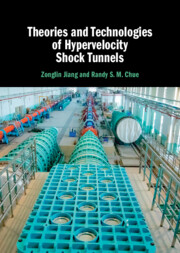Book contents
- Theories and Technologies of Hypervelocity Shock Tunnels
- Theories and Technologies of Hypervelocity Shock Tunnels
- Copyright page
- Contents
- Preface
- 1 Introduction
- 2 Shock-Wave Relations and Aerothermodynamic States
- 3 Heated Light-Gas High-Enthalpy Shock Tunnels
- 4 Free-Piston-Driven High-Enthalpy Shock Tunnels
- 5 Detonation-Driven High-Enthalpy Shock Tunnels
- 6 Theory and Methods for Long-Test-Duration Shock Tunnels
- 7 Methods for Designing High-Enthalpy Flow Nozzles
- 8 Aerothermodynamic Testing and Hypersonic Physics
- Index
- References
7 - Methods for Designing High-Enthalpy Flow Nozzles
- Theories and Technologies of Hypervelocity Shock Tunnels
- Theories and Technologies of Hypervelocity Shock Tunnels
- Copyright page
- Contents
- Preface
- 1 Introduction
- 2 Shock-Wave Relations and Aerothermodynamic States
- 3 Heated Light-Gas High-Enthalpy Shock Tunnels
- 4 Free-Piston-Driven High-Enthalpy Shock Tunnels
- 5 Detonation-Driven High-Enthalpy Shock Tunnels
- 6 Theory and Methods for Long-Test-Duration Shock Tunnels
- 7 Methods for Designing High-Enthalpy Flow Nozzles
- 8 Aerothermodynamic Testing and Hypersonic Physics
- Index
- References
Summary
Hypersonic and high-enthalpy wind tunnels have been a challenge in ground testing facilities in aerospace research for decades. In regard to performance requirements, theories and methods for designing hypersonic flow nozzles at high enthalpy conditions are quite difficult, but very interesting topics, especially when dissociation of air molecules take place in test-gas reservoirs. In this chapter, fundamental theories and important methods for nozzle design are reviewed with the emphasis on two-dimensional axisymmetric nozzles for hypersonic high-enthalpy wind tunnels, including the method of characteristics, the graphic design method, the Sivells method, the theory for boundary layer correction, and computational fluid dynamics (CFD)-based design optimization methods. They were proposed based on several physical issues covering the expansion wave generation and reflection, boundary layer development, and real-gas effects of hypersonic flows. Difficulties arising from applications of these methods in high-enthalpy nozzle design are discussed in detail and state-of-the-art of nozzle design technologies that have been reached over decades are summarized with some brief comments.
- Type
- Chapter
- Information
- Theories and Technologies of Hypervelocity Shock Tunnels , pp. 192 - 235Publisher: Cambridge University PressPrint publication year: 2023



